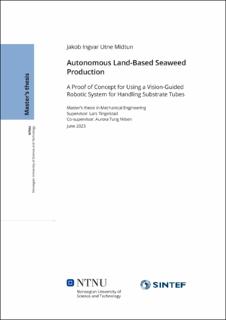| dc.contributor.advisor | Tingelstad, Lars | |
| dc.contributor.author | Midtun, Jakob Ingvar Utne | |
| dc.date.accessioned | 2023-10-18T17:19:40Z | |
| dc.date.available | 2023-10-18T17:19:40Z | |
| dc.date.issued | 2023 | |
| dc.identifier | no.ntnu:inspera:146977797:35324949 | |
| dc.identifier.uri | https://hdl.handle.net/11250/3097351 | |
| dc.description.abstract | Tare er en ressurs med stort potensial. Dagens produksjon er arbeidskrevende og tidskrevende. Hvis et høykostland som Norge ønsker å produsere tare i stor industriell skala, er automatisering essensielt. SINTEF Ocean har utviklet et system for landbasert produksjon av tareplanter som fungerer med manuelt arbeid, men som er ment å gradvis automatiseres ved å teste og implementere ny teknologi. Systemet baserer seg på sylindre som er viklet med tau der taren kan vokse. Disse sylinderene kalles substratrør, og vekstprosessen foregår i vannfylte inkubatorer.
Denne masteroppgaven tar for seg å utvikle og teste et robotisert system for håndtering av disse substratrørene. Prosjektets mål var å skape et "proof of concept" som viser at en robotarm med en spesialdesignet griper kan løse produksjonsoppgaver. Delmålene var å få på plass en fungerende kommunikasjon for å kontrollere en robot og samle inn data fra et 3D-kamera, utvikle et datasynssystem for å veilede roboten, utvikle en eller flere gripere for håndtering av substratrør og å verifisere systemet gjennom testing. Oppgaven med å lokalisere og plukke opp substratrørene fra en inkubator ble ansett som den mest utfordrende oppgaven, og ble derfor hovedfokuset.
De viktigste komponentene i det robotiserte systemet var en DENSO VS-087 robotarm med høy vanntetthet, et Intel RealSense D415 3D-kamera, griperprototyper og datamaskiner med programvare for både bildebehandling og styring av roboten. Et program for rørdeteksjon som benytter punktskyer og referansemarkører ble utviklet i Python. For å kunne bruke kamera-detekterte substratrør, var det også nødvendig med nøyaktig kalibrering av posisjoneringen av kameraet og roboten.
Resultatet var et system i stand til å plukke opp et tilfeldig plassert substratrør i en inkubator. Systemet viste også potensial for å telle og lokalisere flere substratrør i en inkubator. Prototypene av griperene og datasynssystemet beviser muligheten for å bruke et slikt system for håndtering av substratrør, og anbefales videreutviklet for å skape et effektivt system for tareproduksjon. | |
| dc.description.abstract | Seaweed is a resource with a large potential. Today's production is labor-intensive and time-consuming. If a high-cost country like Norway wants to produce seaweed on a large industrial scale, automation is key. SINTEF Ocean has developed a system for land-based seaweed seedling production that is functional with manual labor but intended for gradual automation by testing and implementing new technology. The system revolves around cylinders, or tubes, wound with rope on which seaweed seedlings can grow. These cylinders are called substrate tubes, and the growing process occurs in water-filled incubators.
This master's thesis deals with the development and testing of a robotic system for manipulating these substrate tubes. The project's objective was to create a proof of concept that a robotic arm with a specially designed gripper could solve the tasks of the production system. The sub-objectives were to create a functioning signal pipeline to control a robot and gather data from a 3D camera, develop a computer vision system to guide the robot, develop grippers for handling the substrate tubes, and verify the system by conducting tests. The task of localizing and picking up substrate tubes from an incubator was considered the most challenging and therefore became the main focus.
The main components of the robotic system were a DENSO VS-087 robotic manipulator with a high waterproof rating, an Intel RealSense D415 3D camera, prototypes of gripper designs, and computers containing software for both manipulating images and controlling the robot. A tube detection program using 3D data and fiducial markers was created in Python. In order to use the camera-detected substrate tubes, accurate calibration of the positioning of the camera and robot was necessary.
The result was a system capable of picking up a tube arbitrarily placed in an incubator. The system also showed promise for counting and localizing multiple tubes in an incubator. The gripper prototypes and computer vision system both prove the possibility of using such a system for handling the substrate tubes and are recommended for further development to create an efficient system of seaweed production. | |
| dc.language | eng | |
| dc.publisher | NTNU | |
| dc.title | Autonomous Land-Based Seaweed Production | |
| dc.type | Master thesis | |
